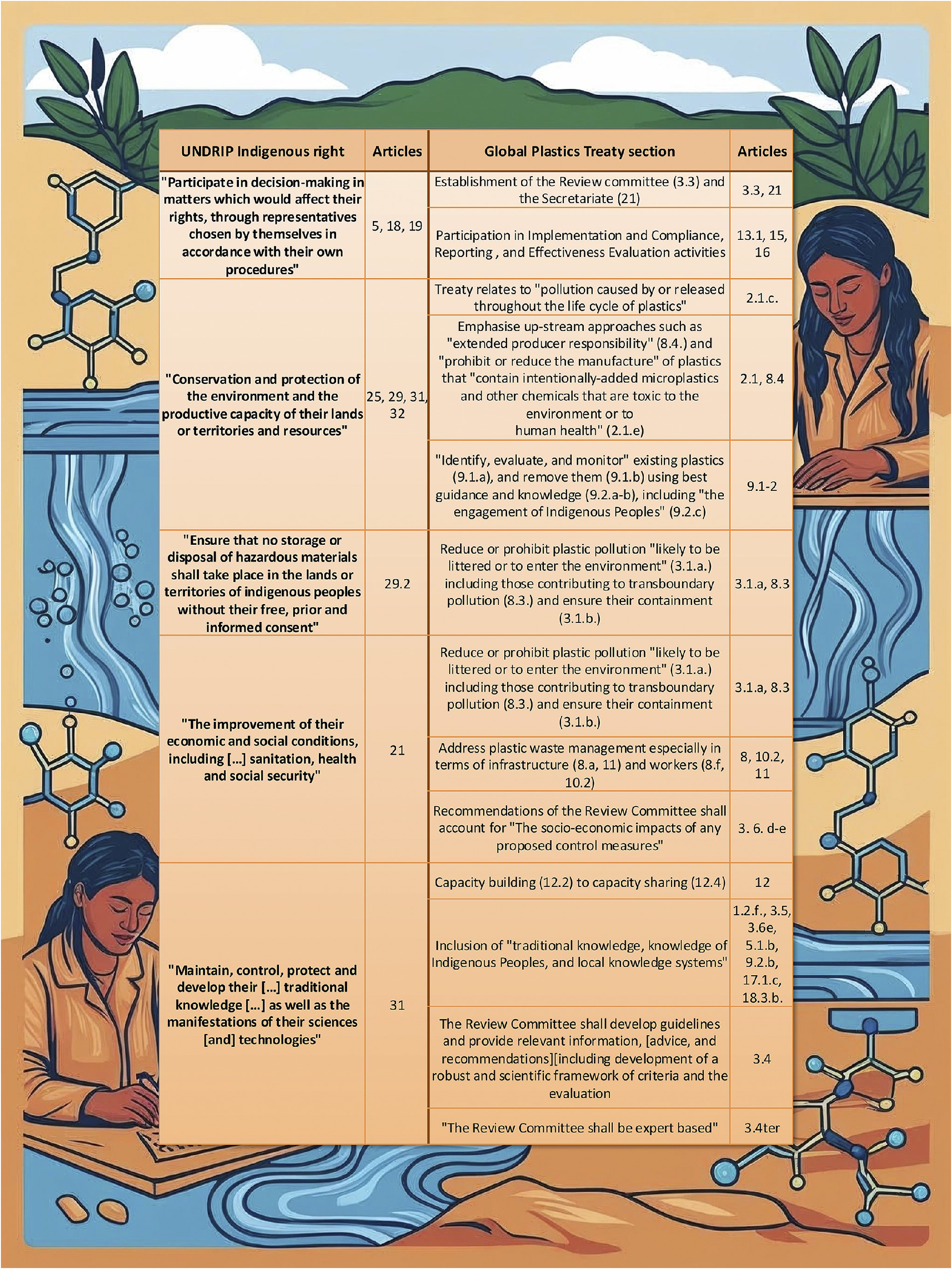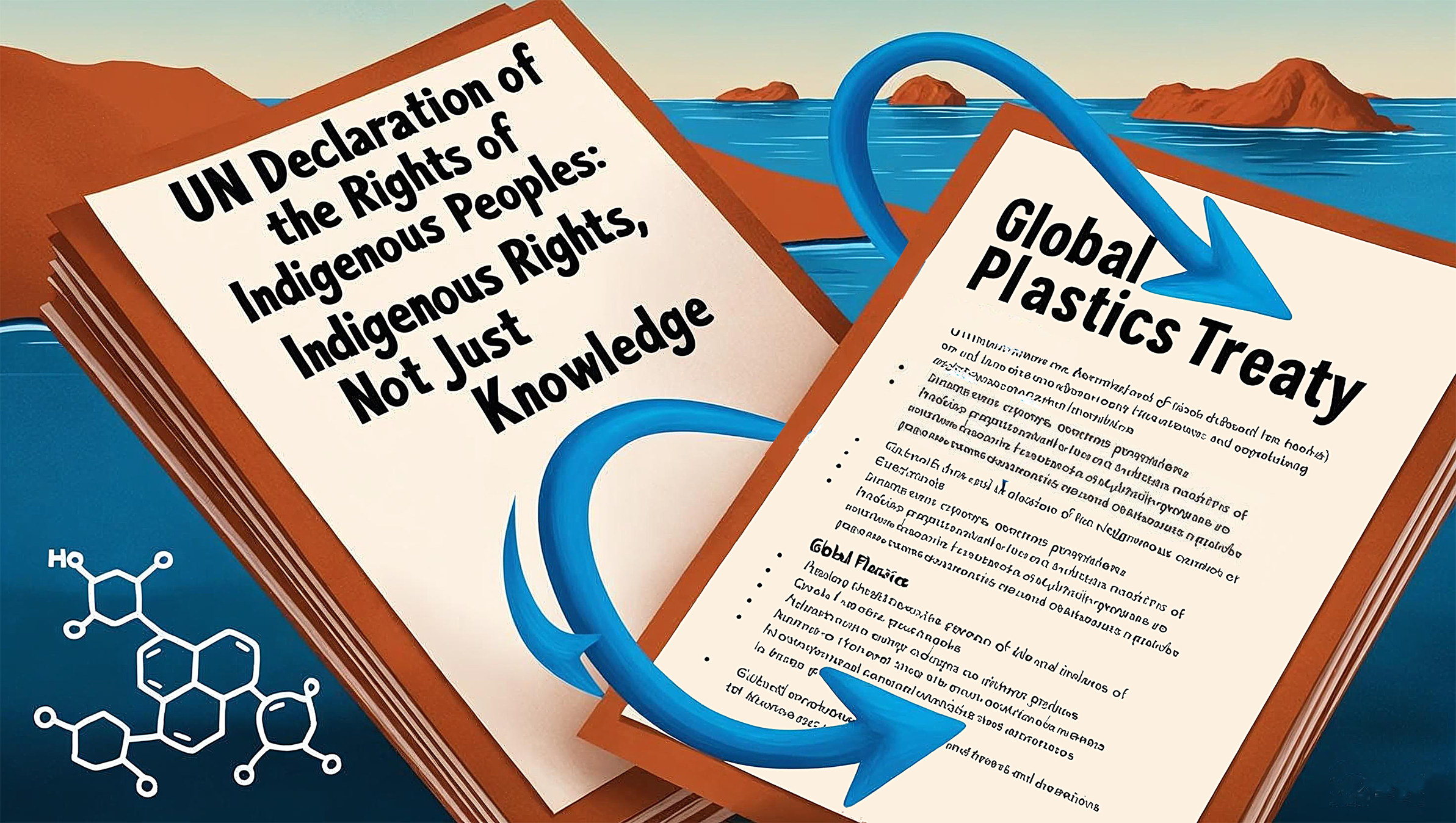Since the 1980s, international governance documents have acknowledged the importance of recognizing, incorporating, and protecting Indigenous Peoples’ rights and knowledge related to environmental governance. This trend continues, albeit unevenly, in the draft Global Plastics Treaty (UNEP, 2024). The primary issue with the current draft is that while Indigenous knowledge is referenced, Indigenous Peoples are absent.
Indigenous Peoples are rightsholders, not stakeholders (IIPFP, 2024a, 2024b). Indigenous Peoples and Nations possess sovereignty, legal rights and intergenerational responsibilities for their ancestral lands and waters that are distinct from and beyond the interests of stakeholders. The International Indigenous Peoples’ Forum on Plastics (IIPFP) has emphasized that the Treaty must “recognize that Indigenous Peoples have distinct status and inherent collective rights enshrined in the United Nations Declaration on the Rights of Indigenous Peoples (UNDRIP)” (UN, 2007; IIPFP, 2024a). The Declaration and the Treaty – both authored by United Nations bodies – have the potential to reinforce one another (IIPFP, 2024a, 2024b), but this alignment has not yet materialized, even in the most robust Treaty drafts.
The draft Treaty offers three sets of “Principles and Approaches” (Article 1). Only one includes “The use of relevant traditional knowledge, knowledge of Indigenous Peoples and local knowledge systems” (UNEP, 2024,1.2.f). Even within that version, the emphasis is on Indigenous knowledge rather than on Indigenous Peoples themselves (UNEP, 2024,1.2.f, 3.5, 3.6.e, 5.1.b, 9.2.b, 17.1.c and 18.3.b). This reflects a common pattern of extracting value from Indigenous communities for non-Indigenous goals without upholding Indigenous rights: to self-determination, to governance of Indigenous lands and waters and to free, prior and informed consent.
The IIPFP makes clear that “the knowledge and science of Indigenous Peoples [must] only [be] considered in conjunction with protections and safeguards that guarantee the full and effective participation of Indigenous Peoples holding that knowledge” (UN, 2007; IIPFP, 2024a). There remains a significant opportunity to integrate Indigenous rights into the Treaty, especially when such inclusion is guided by UNDRIP (see Table 1 and IIPFP, 2024a). Central to these rights is the participation of Indigenous representatives in decision-making bodies (Table 1, Row 1; Ecojustice, 2024).
This argument stems from an approach that begins with Indigenous rights and then turns to the Global Plastics Treaty, rather than framing Indigenous Peoples as resources that can enrich the Treaty. Several imperatives support this approach. First, Indigenous Peoples are not value-added assets to be leveraged by Parties or Committees outlined in the Treaty (Liboiron, Reference Liboiorn2021). Second, under international human rights law, all rights are inalienable and immutable – they cannot be subordinated to the desires of other stakeholders (Liljeblad, Reference Liljeblad2023). Third, while the Treaty references Indigenous knowledge, without the broader socio-epistemological frameworks from which that knowledge arises, it will often be misinterpreted or misapplied, weakening the reason for its inclusion in the first place (UNEP, 2024; IIPFP, 2024a, Principle 6; Liboiron and Cotter, Reference Liboiron and Cotter2023).
For example, when a state Ministry for the Environment compared its 8 indicators of freshwater health with the 29 developed by Māori, only 4 overlapped. The Māori indicators included “fitness for cultural usage” and “the number of species of traditional significance that are still present” (Tipa and Teirney, Reference Tipa and Teirney2006, p. 2). Indigenous knowledge is not simply a dataset – it is a system of understanding that is intergenerational, place-based, relational and grounded in responsibilities to land and water. It cannot be separated from the Peoples who hold and maintain it.
A core barrier to aligning the Treaty and the Declaration remains that “this treaty is being negotiated in rooms where Indigenous Peoples have been excluded” (Elliott, Reference Elliott2024; Jacobs, Reference Jacobs2024; IIPFP, 2024b, 2025). Even if the Treaty begins to integrate UNDRIP (see Table 1), two critical issues persist.
First, the Treaty assigns authority to “The Parties” – the state actors bound by the convention (UNEP 2024, Article 2.a). These states often fail to recognize the legal personality and sovereignty of Indigenous Peoples (Brown, Reference Brown2024). This structural exclusion underscores the need to incorporate Indigenous Peoples into the Treaty’s Committees and Secretariat (Table 1, Row 1; IIPFP, Point 12).
Table 1. Points of conversion of articles in the United Nations Declaration of the Rights of Indigenous Peoples (UNDRIP) and articles in the draft Global Plastics Treaty (UNEP/PP/INC.5/8)

Second, the Treaty may allow for the inclusion of Indigenous knowledge without the Peoples or rights that contextualize and protect that knowledge. For instance, Article 3.6.e states that the Review Committee should consider “[where relevant] the incorporation of [relevant] traditional knowledge, [knowledge of] Indigenous Peoples” (UNEP, 2024). The determination of what is “relevant” must be made by Indigenous Peoples themselves, which requires their presence in governance structures, a place where they are currently absent. While well-intentioned, the draft Treaty is part of an inherited trend of the extraction, misuse, theft, misunderstanding and misattribution of Indigenous knowledge by outside users, often on behalf of Indigenous Peoples and lands without them (see GIDA, 2022).
The only way to safeguard Indigenous rights is through Indigenous governance and decision-making authority (Liboiron and Cotter, Reference Liboiron and Cotter2023; IIPFP, 2024b). The current draft of the Global Plastics Treaty falls short by excluding Indigenous Peoples from decision-making roles while incorporating their knowledge in ways that are disconnected from their rights. This is not simply a call for “inclusion”; it is a call for governance infrastructure.
The IIPFP has already provided clear definitions, principles and structures that can guide the Treaty toward a rights-based and Indigenous-led framework (2024a). Aligning the Declaration and the Treaty would strengthen both. Without this alignment, the Treaty risks replicating historical patterns of appropriation and exclusion.
Open peer review
To view the open peer review materials for this article, please visit http://doi.org/10.1017/plc.2025.10003.
Competing interests
The author declares no competing interests.





Comments
Re: Invited manuscript for Cambridge Prisms: Plastics
Dear Emilie McDermott and Steve Fletcher,
Thank you again for the invitation to submit a Letter to the Editor about the Global Plastics Treaty and its relationship to the UN Declaration of the Rights of Indigenous People. One of the core components of the piece is the Table/Figure (table set in an illustration). I can edit or adjust the table if required. I chose to put a citation on the figure in case it circulates without the article.
All good wishes,
Max Liboiron